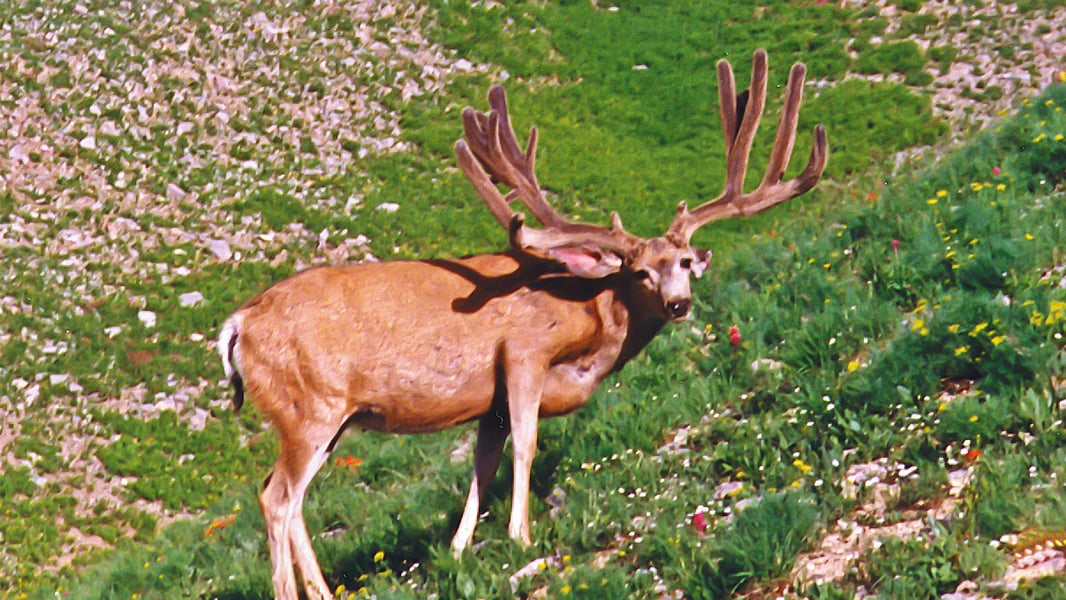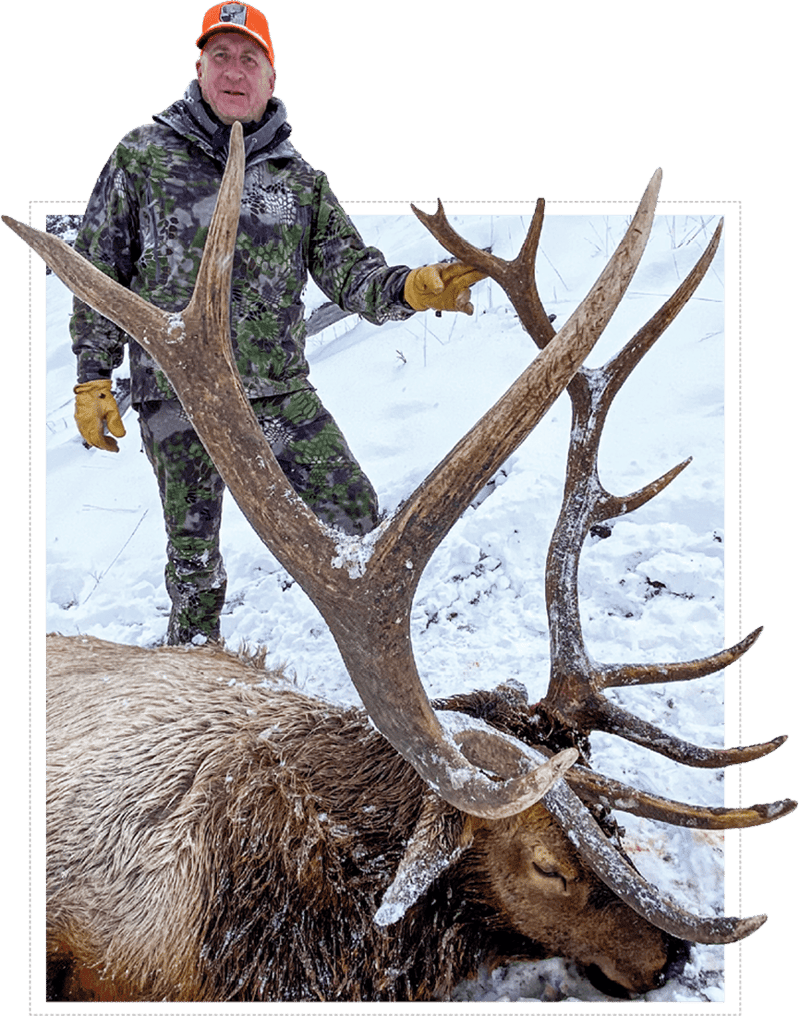Big Bucks…Are Where Ya’ Find Em’
By Guy Eastman
To produce big results on big mule deer, scouting or locating a buck ahead of time is one of the most effective tools to bringing home a big deer. Scouting and locating deer through the fall months is almost an art form. Learning where and how to look as the fall season changes can improve your outcomes drastically.
It’s important to remember a few key points no matter when you find yourself scouting for big bucks. First and foremost, get the absolute best optics you can afford, particularly when it comes to a spotting scope, even if you have to borrow one. A top quality, high-end spotter should extend your effective glassing range to well beyond two miles on bucks under perfect conditions. Next, always utilize the shadows and cover. I always try to glass from a shady spot and in front of an obstruction like a stump or deadfall log. This will allow you to move around more freely without a big buck picking you off from across a canyon. And always remember, big bucks can be very, very smart. When and if that sixth sense kicks in, he can change up his routine or disappear in the dead of night putting you back to square one. For this reason, try not to get too close to a pre-scouted buck; a thousand yards or more is the safest bet in my experience. Anything under 500 yards is just too risky and can be a recipe for disaster.

Late Summer – Scouting on the Red – Hands down, the best way to inventory your deer area is to scout the bucks during the final weeks of summer, which my dad and uncles always called “scouting on the red.”
The prime weeks for scouting this phase are generally the final few weeks of August. The advantages here are bucks with their red summer coats glowing in the sun, bachelored-up bucks giving you more of an idea of what the area has to offer, and a green landscape that pops animals off the steep hillsides like beacons. The bucks’ racks should be just about fully grown by the 10th of August in most areas, giving you a very good idea of what a buck is to become.
The best strategy here is to get on a high point with the sun at your back and cover country both with boot and glass. Generally speaking, the south slopes will be too hot this time of year and the north slopes too thick, leaving a prospective hunter to glass east and west. I usually try to glass the west slopes in the morning and the east slopes in the evening. The key factor with this technique is to find the glassing sweet spots, the places that expose the best and most country from one vantage. Next, get the best glass you can afford, you’re going to be living behind it for hours on end. A high-quality 80mm spotter with a very solid tripod is usually the best tool to have on hand. The final step is to get comfortable and be thorough. Make sure to utilize the first and final hours of daylight each and every day.
I usually try to start at the very top of a creek drainage and work my way down, either by boot leather or glass. Working a knife ridge down can give you a vantage point of two drainages or more in a single descent. Sometimes if you pick the correct ridge you can see three or four drainages on one trip out. This often presents to you a very wide swath of country with minimal effort.
If you find a buck you like, stick with him and study his behaviors and patterns for at least one evening and morning or more. Don’t count out a few midday movements as well; a mid-morning or early afternoon water stop might be a real possibility for bucks this time of year.

Early Fall – Post Velvet – Once those big bucks drop their velvet, things will change drastically.
In the northern states, Wyoming, Idaho, Montana and northern Colorado, the bucks will generally shed their velvet around the 10th of September. Add two or three full weeks to that for the southwestern states. An early heavy rainstorm will accelerate this process by a week or ten days. The moisture does not play well with the velvet.
To scout bucks after the 15th of September you will have to become much more meticulous with your glassing techniques. Once the bucks shed their velvet they will tend to hang much closer to the cover and become much more sensitive to the sunlight. Nocturnal bucks hanging in the shadows are very hard to find, leaving you with the task of picking off the flicker of an ear, turn of a head and even the blink of an eye sometimes. The feeding patterns will become more predicable but the time will be short. As soon as that sun rounds the corner of the eastern sky a mature buck will dive into the timber or aspens, leaving the young guns to fend for themselves, their lack of experience can be disastrous to their lifespan.
If you do find a big buck and he goes “radio silent” on you for a glassing session or two be patient. Sometimes if the feed and moisture are good enough a big buck this time of year will only feed once per day or in the middle of the night and sometimes even in the middle of the day in a sparse timber pocket or bench.
By this time of the fall, the green in the feed has burned off to brown and the buck’s diet has changed drastically. Concentrate your efforts on the brush, timber strips and benches below big basins. During a snowstorm the bucks could very well climb back into the open basin and bed in the open to wait out the storm, a reverse in apparent common logic.
As hard as the bucks can be to find this time of year, the return on your investment of time is they tend to be very content and predicable unless they get bumped by a predator or hunter. This should remain the case up until about the 25th of October and then it all changes again-the pre-rut.

Mid-Fall – Pre-Rut – Toward the end of October the big bucks will tend to split off from the bachelor group and drift into heavy cover while they stage for the upcoming rut.
An early heavy snow can send the bucks into this mode even sooner, sometimes near the 10th of October. This is the hardest phase to find big bucks in. These bucks can often be found mid-mountain, just off the creek bottoms or anchored to big aspen groves. Willows and young aspens are prime for polishing up antlers for battle. This phase will last until the rut starts about the middle of November, give or take a week to ten days.

Late Fall – Rut and Beyond – This one is simple… find the does. The bucks will be concentrated around the does this time of year.
No real surprising news here. What might be of some help though, is to keep in mind, deer are not elk. A buck is not a herd animal. A big buck is on the move this time of year and is never in anyone place for very long. If you do find a big buck in this phase you had better act now. A big buck can easily and often does roll into a creek drainage full of does and rut two or three and move on. This is Mother Nature’s way of mixing up the gene pool.
A big buck is a shy creature and usually will pull a hot doe out of a group and push her up into a tight creek drainage or rough canyon to breed her. This allows him to concentrate 100% on his lady and moves her and her scent out of the open where other pesky Romeos may come calling. Sometimes you will see a big mature buck come and go on and off into a big group of does for two or three days before moving on completely. If you find yourself in this situation be prepared to act fast. Time may not necessarily be on your side.
A mule deer buck has a massive range and can almost seem like a homeless bum at times, here today and gone tomorrow even when he appears completely content. Be patient, cover country and glass from afar. A snowstorm is always a welcome sight this time of year, as it tends to concentrate the bait/does into one place, out in the open.
In conclusion, finding big bucks is not an easy task and I don’t see it getting any easier in the near future. The recipe here is to load up on patience, persistence, and be thorough. Find the best glassing spots that maximize your volume of view and get the best optics you can afford or borrow. Spend as much time behind them as you can and make sure you try to fully utilize those critical first and last hours of the day to find a big shy buck when his guard is let down. And when and if you do find one, cherish the moment, a truly big mule deer is a very rare commodity these days and they certainly do not grow on trees.



